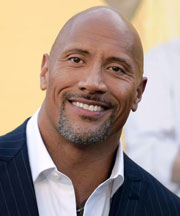Why men make more than women in Hollywood
by Maria Puente
Is the campaign to close the Hollywood gender pay gap stalled? The
gap is still wide - wider even than that for average working women - and
older female stars have it even worse, according to new figures.
This is not news to anyone in Hollywood, particularly women. But it's
getting way more Hollywood buzz now in part thanks to agitation by such
boldfaced names as Oscar winners Cate Blanchett, Patricia Arquette and
Jennifer Lawrence.
|

Dwayne Johnson on June 10, 2016 in Los Angeles. |
|

Jennifer Lawrence in London on May 9, 2016. Roberts and Amy
Adams. (Photo : DANIEL LEAL-OLIVAS, AFP/Getty Images ) |
"The fact that people are paying attention to this is what's new -
it's only in the last couple of years and only since the actresses
started talking about it," says activist Melissa Silverstein, founder of
the Women and Hollywood website which tracks this issue.
"What's happening now is that women in Hollywood are emboldened to
talk about gender discrimination - you can't turn a blind eye to this
issue anymore."
People were talking about it because once again, annual Hollywood
earning data compiled by Forbes magazine illustrates the pay disparity.
The magazine's list of top-earning male stars shows that Lawrence, who
topped the magazine's female stars list with $46 million, earned only
about 71% of what the top male star, Dwayne Johnson, earned, at $64.5
million. Lawrence would be only the 6th-highest-paid star if the male
and female lists were combined.
For comparison purposes, the U.S. Census Bureau's most recent
calculations of median average pay for women and men, in September 2015,
found that women make about 79 cents for every dollar paid to men, a
statistic that hasn't changed much in half-dozen years. That means
ordinary working women are slightly better off in these sorts of
calculations than the likes of Lawrence, star of one of the most
lucrative box-office movie franchises, The Hunger Games.
Forbes calculates the stars' earnings between June 1, 2015 and June
1, 2016, before taxes and before the deduction of management fees, using
data from Nielsen, Box Office Mojo and IMDb, and from interviews with
agents, managers and lawyers. These calculations are not based on the
box office revenues of the stars' movies.
The latest list, which repeats patterns from previous years,
illustrates other discrepancies, such as the one for age: All of the top
10 male earners are over 40 compared to only half the top 10 women
earners, which includes Melissa McCarthy, Jennifer Aniston, Charlize
Theron, Julia Roberts and Amy Adams.
So why is the pay gap in Hollywood still a reality? Because it's
still a reality in the larger culture, says Martha Lauzen, head of the
Center for the Study of Women in Television and Film at San Diego State
University.
"If those larger culture under-values women's contributions, it is no
surprise that the film studios do the same," Lauzen says. "Contrary to
popular belief, in many ways the mainstream film industry remains a
staunch supporter and reinforcer of the status quo, particularly when we
are talking about gender, race, and similar issues." Among the truisms
Hollywood embraces is the idea that male stars are better box-office
draws than women stars, she says.
"It remains part of the conventional wisdom in the mainstream film
industry, in spite of a growing body of research" that shows instead
it's "the size of the budget, not the sex of the protagonists or
filmmaker, that determines box office grosses," Lauzen says.
Cathy Schulman, Oscar-winning veteran producer and president of Women
In Film, Los Angeles (most recently head of production at STX, where her
film Bad Moms is a summer hit "must see" for women audiences), says
there is a "round-robin" of problems behind pay inequity, including
male-favoring global audiences, unconscious bias, and the length of time
it takes women to get their next paying industry job compared to men.
But one bottom line, she says, is that "women actors aren't given pay
raises at the same rate as men are - it's just a fact." She says the
in-flux payment system for Hollywood talent is based on "previous
quotes," or whatever the talent was paid in a previous job coupled with
success of the movie.
"What we're seeing is that when people are getting raises, it's
directly related to whether it follows a hit movie," Schulman says."But
the jumps in 'quote' are way bigger for men than they are for women at
the moment, and it has to do with who is doing the negotiating and who
is buying the talent. We've not seen the agencies, studios and financers
fight for that kind of quote-doubling with women as much as men."
- USA TODAY
|

